10 beautiful, low-maintenance xeriscape ideas to recreate at home
Try these xeriscape ideas to transform your yard into an easy-care, low-water landscape
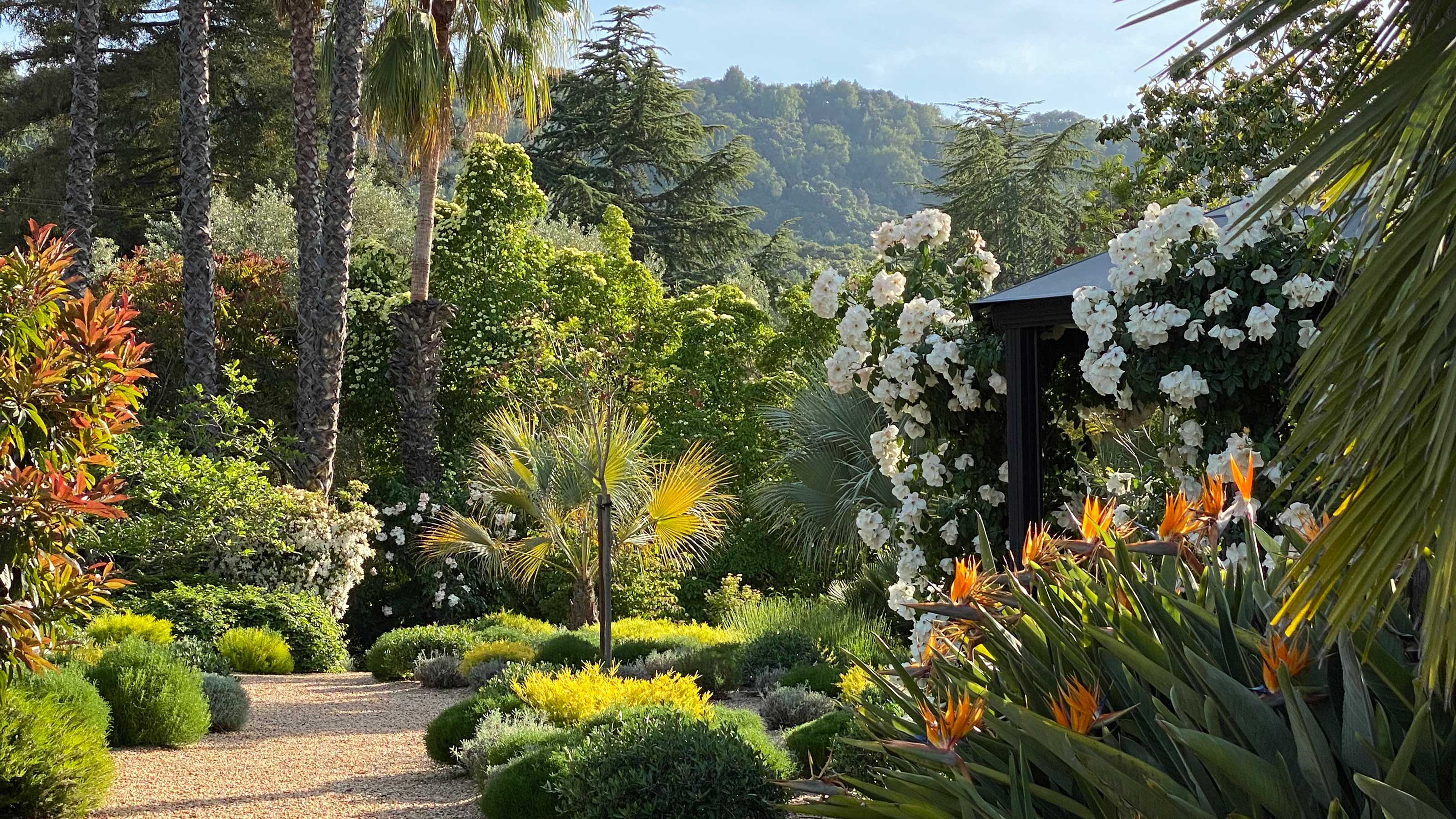

Trying out some xeriscape ideas is a great solution if you want to create a beautiful, wildlife-friendly, cost-effective backyard in an arid State such as California, Nevada or Arizona.
These low-water, low-maintenance gardens include colorful native flowers, lawn look-a-likes and elegant shade trees to make your yard glow all year round. And with water bills soaring and utility companies in many States now offering incentives to replace thirsty lawns with drought-tolerant plants, now is the perfect time to plan one.

Using a palette of desert native plants that need little irrigation, Shelly Ann Abbot of Landscape Design West, LLC has created this beautiful xeriscape in the heart of Arizona
10 stunning xeriscape ideas that are easy to look after
To inspire you, here are ten suggestions to include in your xeriscape ideas, with tips from expert landscape designers to help you make the right planting choices and create the perfect scheme for your plot. And if you need more info getting started, our xeriscaping guide has lots more practical tips.
1. Replace your lawn with drought-tolerant alternatives

Lomandra ‘Lime Tuff’ produces this beautiful grassy effect in a garden designed by Chris Jacobson
Lower your water bills and help the environment by replacing thirsty lawn turf with drought-tolerant plants. There are plenty that will provide a beautiful grassy effect while requiring little or no additional irrigation.
Rob Moore of California Native Landscape Design suggests kurapia, a versatile groundcover plant bred from the Japanese native Lippia nodiflora. 'This little green creeping plant grows close to the ground and rarely exceeds one or two inches in height, and it can tolerate light foot traffic.
'However, for most of the year, it’s covered in small white flowers that attract bees and butterflies, so while good for pollinators, you have to watch your step if you walk on it,' he adds. 'Once established, it requires little maintenance or water.'
In areas where you don’t intend to walk on the planting, try taller grasses and sedges, such as the California native field sedge, Carex praegracilis, which is bright green and grows to 2–3ft; the wispy green meadow sedge (Carex pansa); deer grass (Muhlenbergia rigens) with its fountains of narrow green leaves; or the blue fescue, Festuca californica, available at Nature Hills. It's a naturally compact ornamental grass with icy blue-green foliage.
Or, try the Australian lomandras, which also produces a grassy effect. These plants do not tolerate foot traffic but will provide a beautiful, low-water and easy-care textured surface.
2. Go native with planting
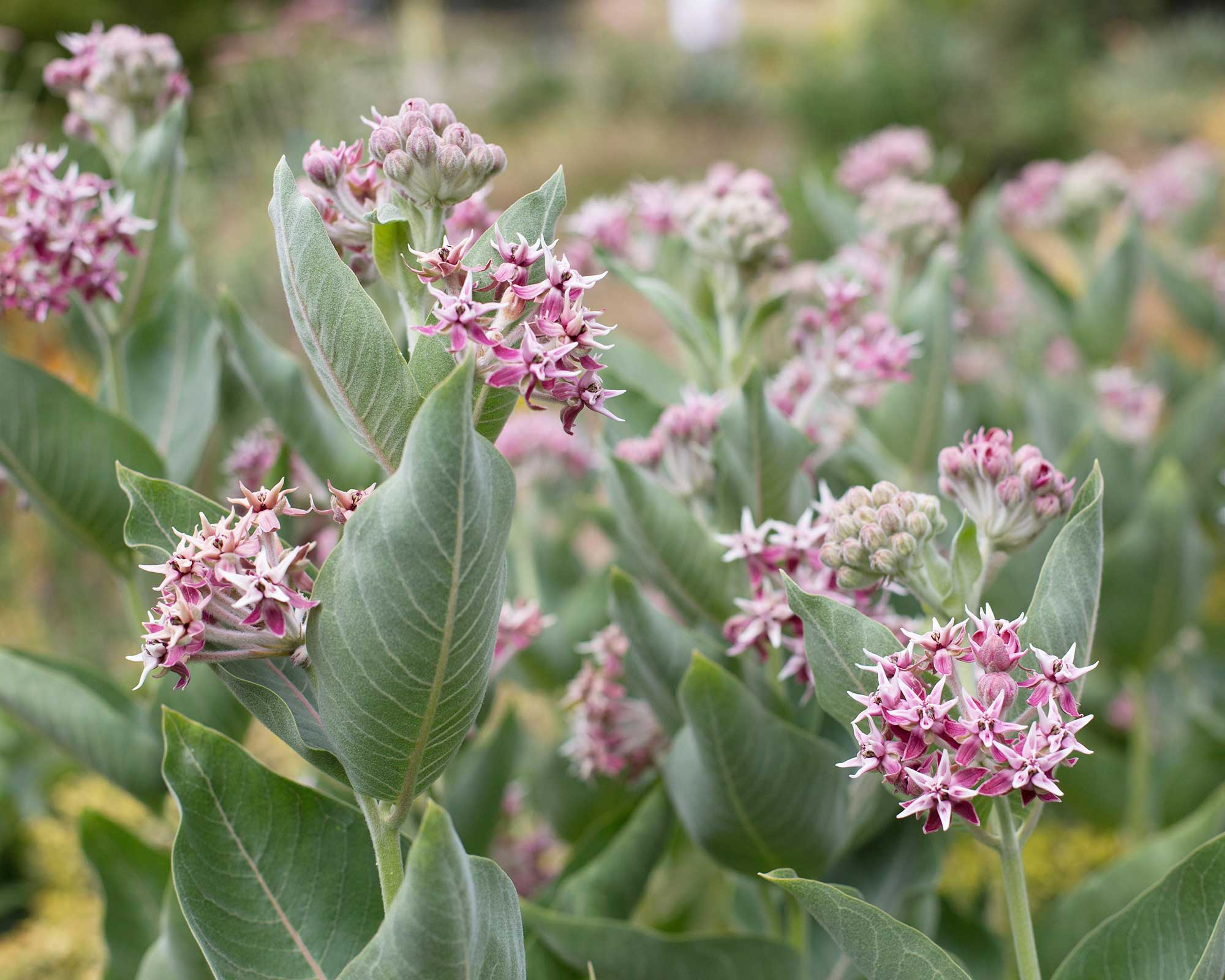
The small pink fragrant blooms of the Californian native showy milkweed (Asclepias speciosa) make a colorful display in a xeriscape and attract a host of butterflies
Plants that grow in the wild in drought-prone areas are adapted to long, dry periods and will sail through hot summers unscathed. However, Rob Moore warns that many natives prefer poor soil and could suffer in the enriched, fertile dirt often imported to grow non-natives in domestic yards.
'All the natives I use grow well in these richer conditions, while also withstanding six to nine months of drought per year. My favorites include shrubby evergreen California lilacs, such as the tall Ceanothus "Concha" and low-growing C. gloriosus "Anchor Bay"; buckwheat (Eriogonum fasciculatum), an evergreen shrub that grows to about 4ft in height and produces pretty pink and white flowers that attract pollinators; perennial milkweed (Asclepias speciosa) with its large gray leaves and fragrant flowers loved by butterflies; and the ground-hugging duddleya succulents, which are extremely drought-tolerant but need a little shade when grown inland.
'I recommend watering these once a month in the summer, using a sprinkler to mimic rainfall and wash off pollution deposits from their leaves which can hamper their growth. In areas closer to the coast where the climate is more humid, you may not need to water as frequently.'
3. Mirror the Mediterranean
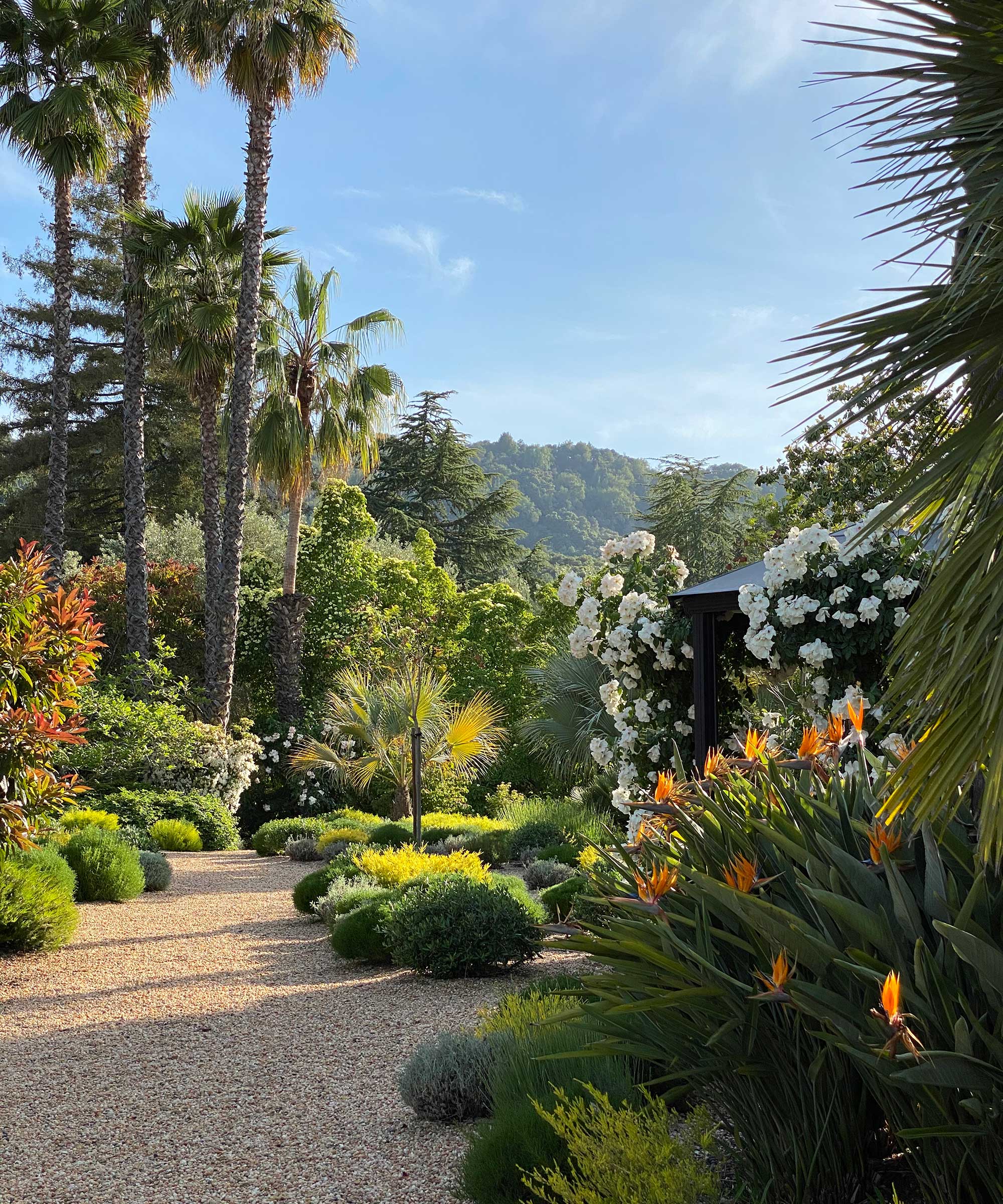
Mediterranean shrubs, such as cotton lavender and rosemary, with orange highlights from the bird of paradise combine to create this stunning landscape by Chris Jacobson
California, southwestern Oregon, and western Nevada have a Mediterranean climate, which means that they experience hot, dry summers with a cooler, rainy season from winter to early spring. So, it’s no surprise that Mediterranean plants also thrive here, delivering a bounty of colorful flowers and surviving on very little water.
Landscape designer Chris Jacobson, the owner of the San Francisco-based Garden Art Group, has created many Mediterranean-style gardens using blue- and pink-flowered salvias, silvery cotton lavender (Santolina chamaecyparissus), and rosemary to produce his low-water schemes.
'For a splash of color, I may also include the Castilla roses (Rosa gallica) in areas such as San Francisco and Santa Barbara where the summers are not too hot. We run an irrigation line to them, so they can be watered a little more often than other plants in the garden, thereby minimizing wastage,' he adds.
'Plants from South Africa, which shares a similar Mediterranean climate to our own – such as the bird of paradise plant (Strelitzia reginae) and African daisies (Osteospermum) – also offer a long season of color in a xeriscape.'
4. Provide food for wildlife
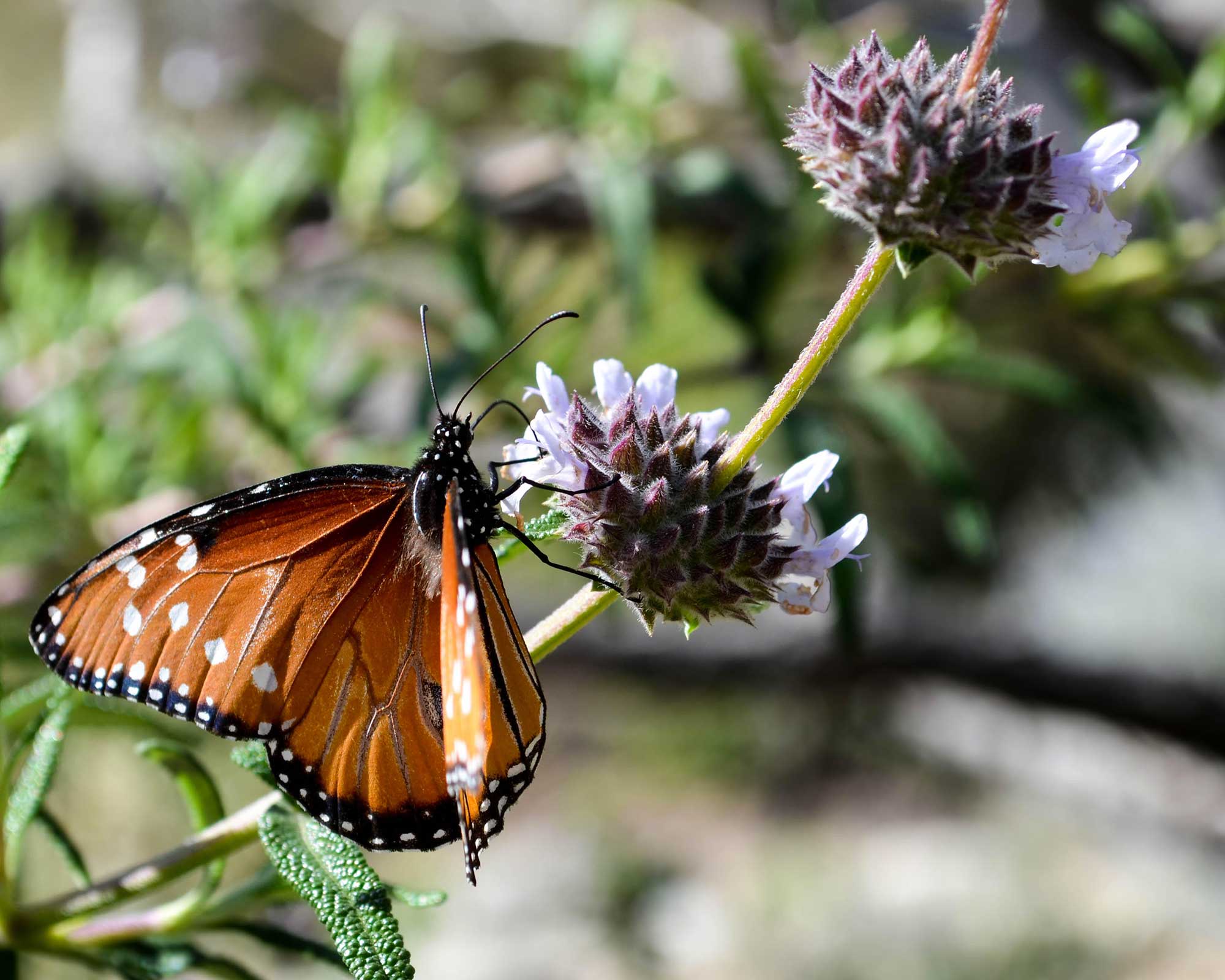
Native salvias will lure a host of beautiful pollinators, such as this queen butterfly, to your xeriscape
Using a xeriscape to make a wildlife-friendly garden is great for the planet and for us, too, bringing a yard to life with hummingbirds, butterflies, bees and lizards.
Simply add some pollen-rich flowers, boulders for shade and shelter, and trees and shrubs that offer birds roosting and nesting sites. Chris Jacobson recommends the New Zealand tea tree plant (Leptospermum scoparium), a tall fall-to-spring-flowering shrub with pink blooms loved by hummingbirds. 'And for the bees, scatter seeds of California poppies (Eschscholzia californica) [available on Amazon] around the yard and it will soon be filled with pollen-rich bright orange and yellow flowers,' he says.
Rob Moore adds: 'My go-to plants for wildlife are the California native sage Salvia clevelandii "Aromas", with its long-lasting lavender-colored blooms that are magnets for butterflies and hummingbirds in late spring and early summer; and buckwheat, an important butterfly plant, with flowers, leaves and seeds also used by smaller animals, making it a good habitat species.
'I also like the native Manzita tree (Arctostaphylos "Howard McMinn"), a showy shrub with nectar-rich flowers from winter to spring that attracts insects for birds to eat, followed by red fruit in fall which other birds enjoy.'
5. Add colorful containers to your xeriscape
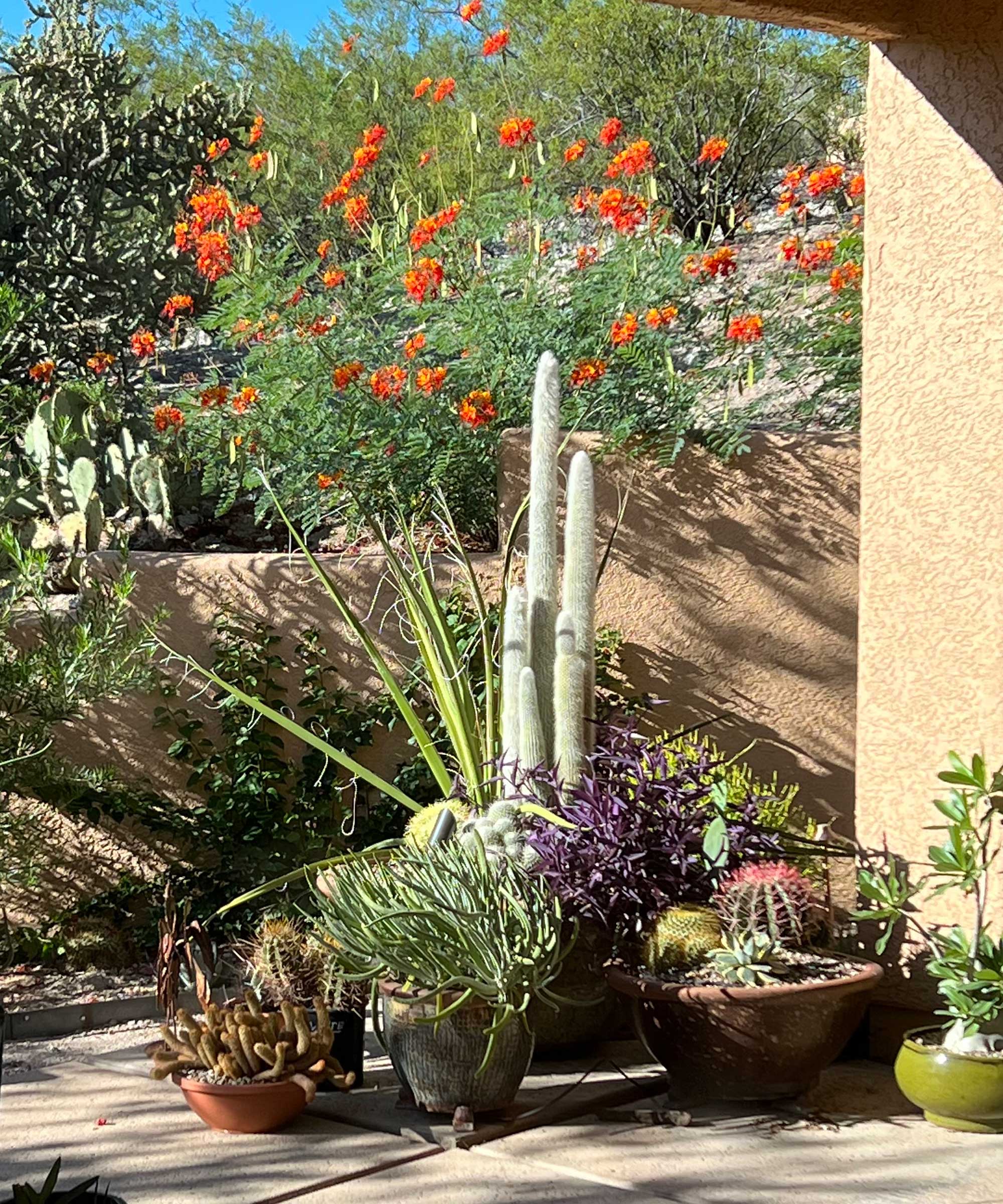
This container display by Shelly Ann Abbot of Landscape Design West, LLC includes the tall woolly torch cactus, barrel cactuses, small succulents and the trailing purple heart (Tradescantia pallida ‘Purpurea’)
A quick and easy way to boost the color and interest in your plot is to plant up some low-water container garden displays.
Shelly Ann Abbott, owner of Tucson-based landscape company Landscape Design West, LLC uses tough cacti and succulent plants that tolerate the scorching summers and cold winters in Arizona. 'First, locate the best place for your plants, away from the full glare of the summer sun and cold north-facing sites in winter. If they are light enough you can move them, of course, depending on the season,' she says. 'Make sure your containers have drainage holes in the base, and use a cactus potting soil [available on Amazon] mixed with a little native soil for your succulents.
'Good plant choices for a large container in sun include the silver torch cactus (Cleistocactus strausii), with its tall woolly stems; the red yucca (Hesperaloe parviflora), which has grassy foliage and tall stems of long-lasting red summer flowers; and spiky agaves. Groups of barrel cactuses also make great container displays.
'For smaller pots or edging for larger ones, try the trailing purple heart (Tradescantia pallida "Purpurea"), which needs a little shade in summer,' she adds.
Shelly also recommends watering plants in pots every few days in the blistering heat of an Arizona summer if you want them to look their best (they will survive with less water but may look a bit lackluster). Irrigation can be reduced to weekly at other times of the year, and to almost none in winter.
6. Bring in the boulders
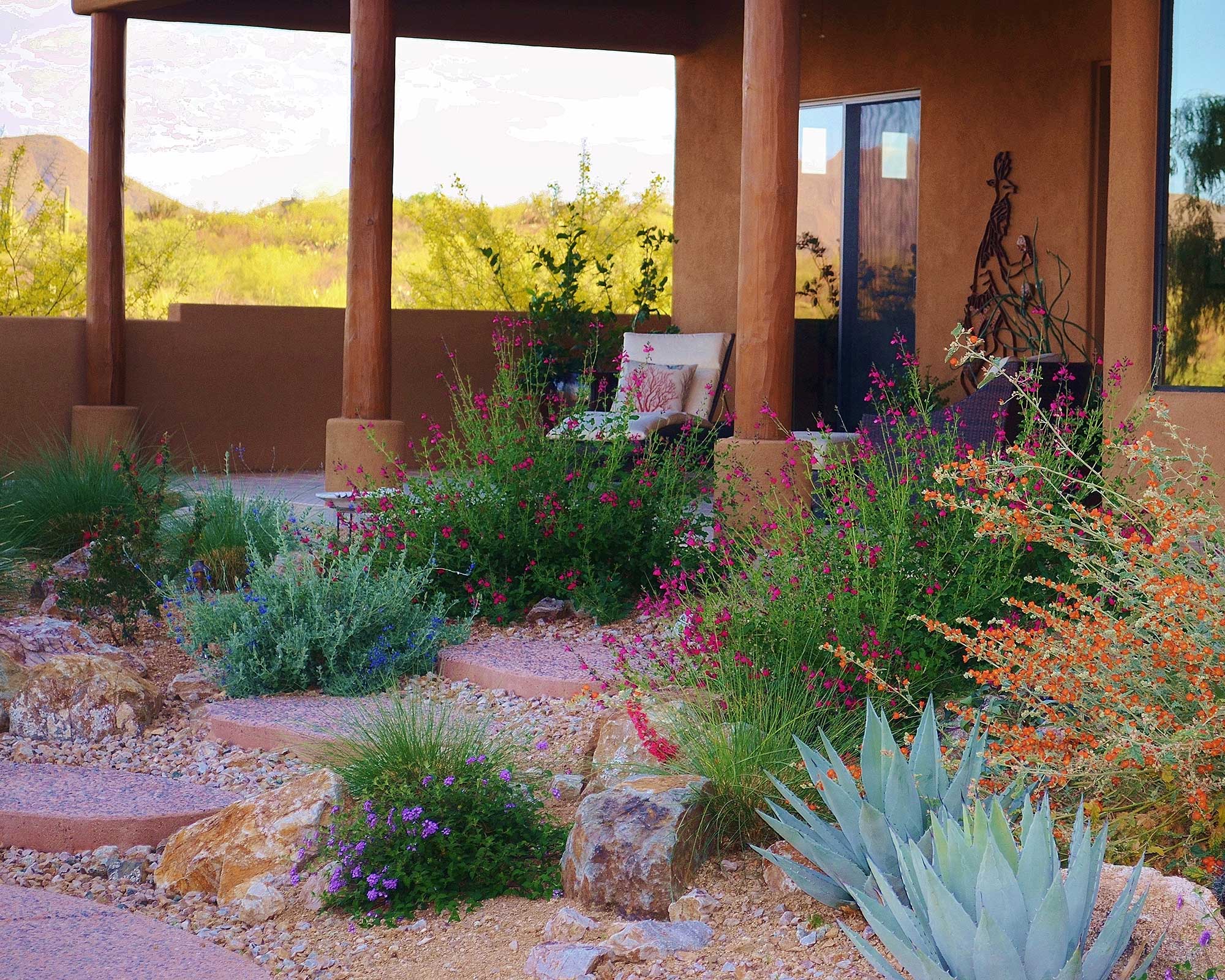
Shelly Ann Abbot of Landscape Design West, LLC uses boulders and stone chip mulches between the plants to trap water in the soil
A neat trick to nurture your low-water plants is to introduce landscaping with boulders into your designs, using local rocks.
Shelly Ann Abbott explains: 'In our desert landscapes here in Arizona, many plants grow close to rocky outcrops, which trap moisture in the soil beneath them. I mimic this idea in my designs, planting close to beautiful boulders of different sizes, which also provide foils for the plants.'
Shelly also adds mulches to protect the soil surface from the sun and reduce evaporation rates after irrigating. 'We use granite or stone chips to cover the ground – wood chips attract scorpions here and are rarely used.'
In other States, wood and bark chips may be used as mulch in areas of the yard away from the buildings, but they can pose a fire risk and are only recommended for small areas.
7. Introduce shade trees

The evergreen foliage of the Californian native Christmas berry will provide cool shade year-round and feed birds such as waxwings when its winter fruits appear
To relax in your yard under the summer sun, introduce some shade with an architectural tree or large shrub.
Trees cool the atmosphere better than manufactured structures by releasing moisture through their foliage in a process known as evapotranspiration. Rob Moore suggests the Christmas berry (Heteromeles arbutifolia) to shade a dining or seating area. 'This lovely evergreen shrub or small tree can be kept to a height and width of 6-8ft, or left to grow into a 20ft multi-stemmed tree, ideal for adding shade to a xeriscape. Another beauty is the Desert Museum parlo verde (Parkinsonia microphylla x Desert Museum), which rapidly grows into a large shrub or small tree, with blue-green trunk, branches, and leaves and yellow summer flowers.'
Chris Jacobson recommends the small, deciduous Chinese pistache (Pistacia chinensis), available at Nature Hills. While not a US native, it is a drought-tolerant tree and has a rounded, umbrella-shaped canopy of finely-divided green leaves that turn shimmering shades of copper and red in the fall. Bright red berries match the foliage in fall and then turn blue-purple over winter, creating a long season of interest, as well as much-needed shade.
Shelly Ann Abbott uses the native desert willow Chilopsis linearis to shade her Tucson gardens. 'I love its slim green leaves and fabulous large flowers that lure hummingbirds. The velvet mesquite (Prosopis velutina) is another favorite of mine – it has no discernible flowers but offers cool shade and is well adapted to a dry, desert climate.' Take care, though, as it is classed as a weed in some States outside its native Arizona.
8. Plant up a slope
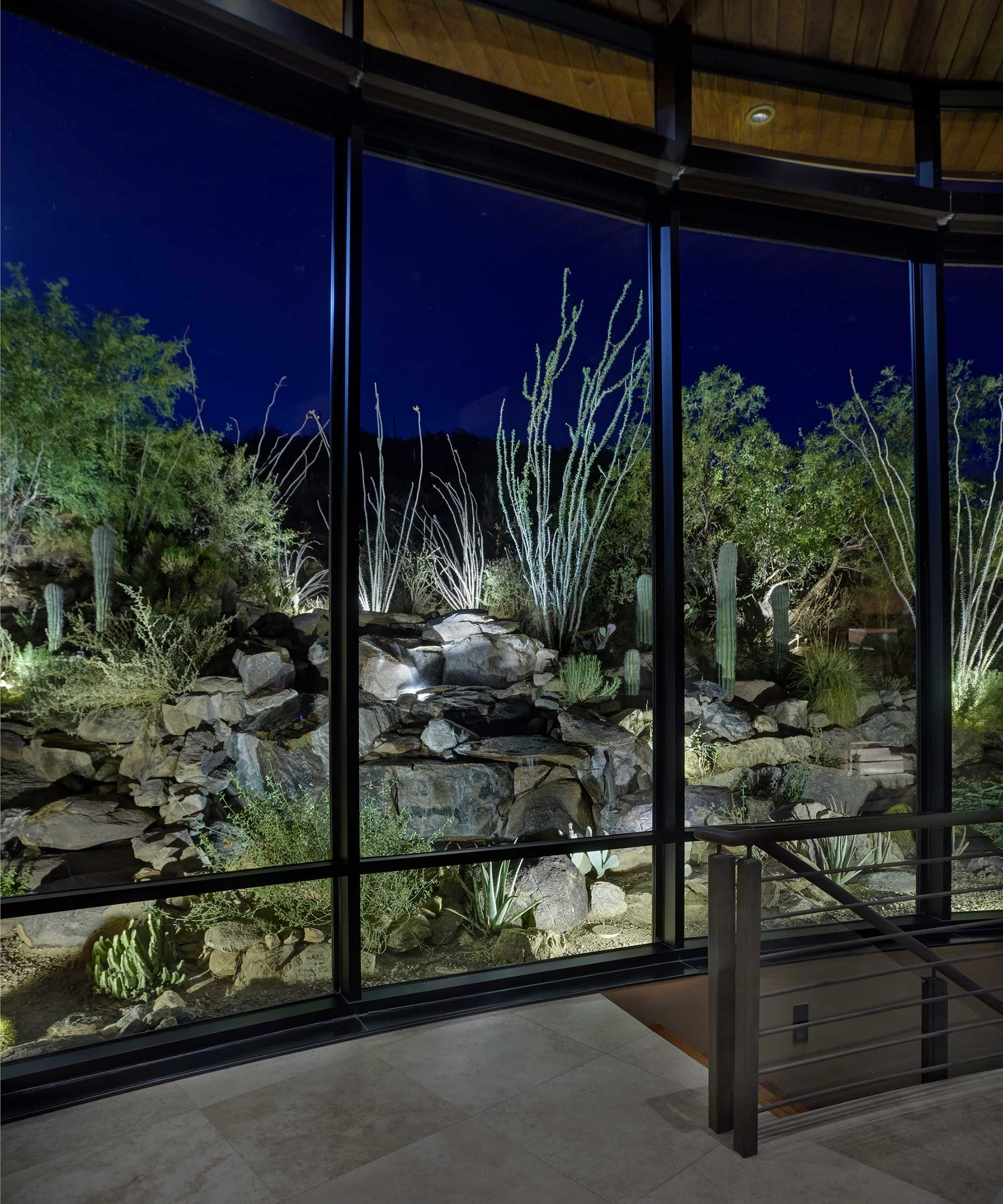
Boulders and rocks help to keep the soil in place and support the plants, which include desert natives such as the ocotillo, in this dramatic sloping xeriscape by Shelly Ann Abbot of Landscape Design West, LLC
Sloping gardens can be the most challenging to design in a drought area because any rain or irrigation will quickly drain to the bottom, leaving the higher ground bone dry.
Shelly Ann Abbott says, 'Arizona is a mountainous region and many gardens here are on hillsides. I use rocks and boulders to help trap water on a slope and keep the soil in place.' She then plants cacti of various sizes; succulents such as the tall desert native ocotillo (Fouquieria splendens); salvias, and the red-flowered chuparosa shrub (Justicia californica) between the rocks.
Rob Moore recommends other flowering natives such as the California fuchsia Epilobium ‘Everett’s Choice’ which grows to just 12in high and about 3ft wide and will hug a slope with its gray-green leaves and bright red flowers. It also tolerates occasional flooding that may occur at the base of a slope.
The trailing rosemary (Rosmarinus officinalis ‘Huntington Carpet’) will also cascade down a slope, its pale blue flowers adding interest in spring. 'The coyote bush Baccharis pilularis "Pigeon Point" is a great erosion control plant that helps to keep the soil in place on hillsides,' he adds. 'Evergreen and neat year-round, it’s a dependable low groundcover with bright green leaves.'
9. Make a dry creek

A dry creek makes a beautiful garden feature. Funneling rainwater through the yard, it will irrigate the plants while helping to slow the speed of stormwater and prevent flooding
Mimic the beauty of a dry stream bed in your yard to create a beautiful feature alongside your other xeriscape ideas. It will improve garden drainage and thus help prevent seasonal flooding, too.
Rob Moore suggests building one at the base of the downspout on your house so that it directs rainwater from the roof through your yard to a low depression or soakaway. A creek bed will also slow the flow of stormwater, giving it time to drain into the soil rather than running off your garden into the street. 'This feature looks great and will funnel any rain that falls on the house along the creek, irrigating the plants en route.'
Simply dig out a shallow trench, about 12 inches deep with sloping sides, to reflect a gently meandering creek. Make sure the bed slopes away from the house and terminates at a pooling point where water can collect and soak into the soil. This area needs to be well within your property lines; it is illegal in most States for stormwater to be directed into the street.
Line the bed with high-quality (not plastic) landscape fabric, then add gravel and small pebbles on top, with larger feature boulders lining the edges. Plant in the spaces alongside the creek bed, looking at natural landscapes in your area for inspiration.
10. Add some produce to your xeriscape
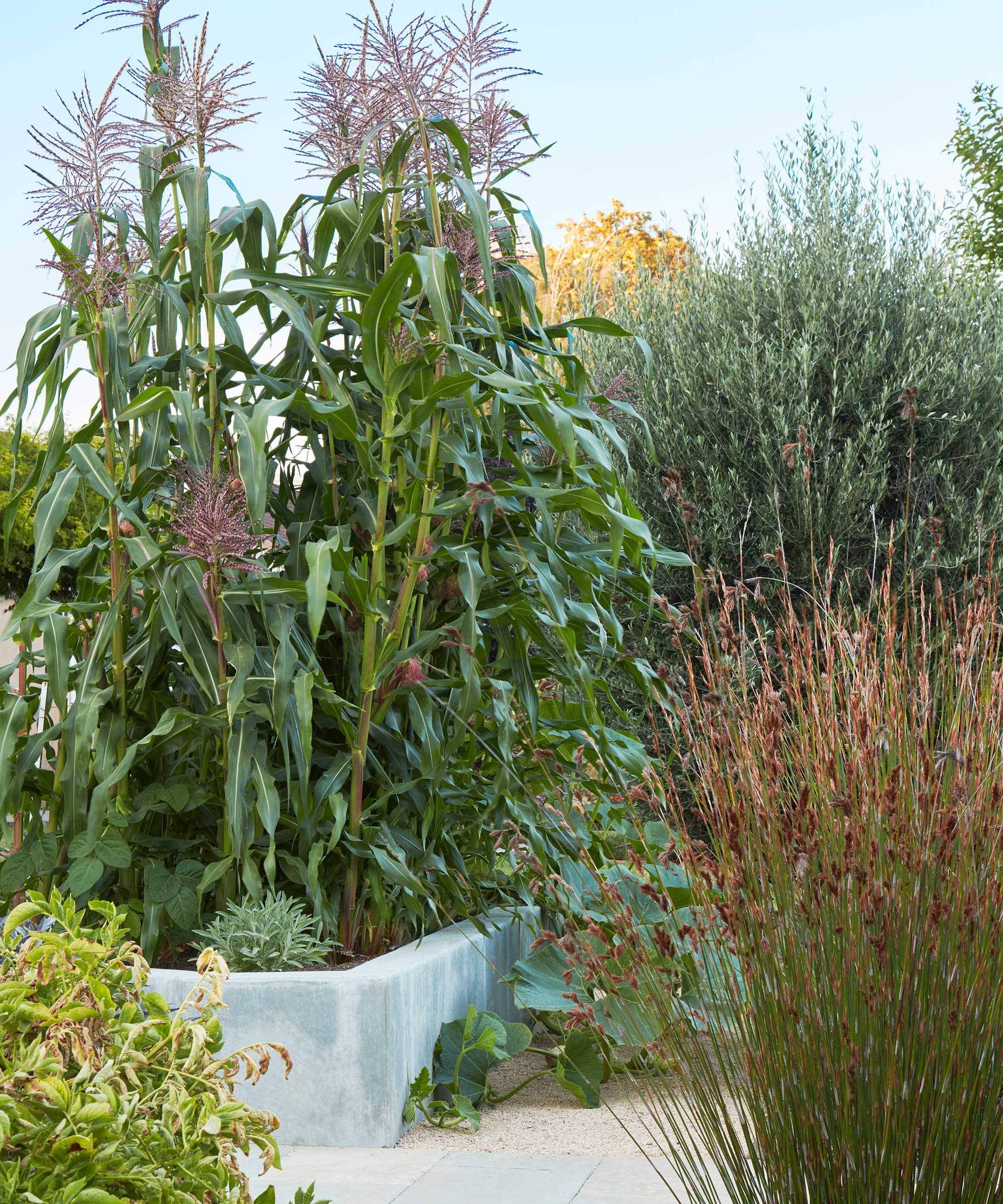
In this garden by Chris Jacobson, drought-tolerant crops such as corn have been planted in raised beds, and a drip irrigation system has been installed to keep the plants hydrated while minimizing waste
Growing your own edible crops is possible in a xeriscape, and many herbs such as sage, rosemary and sweet bay are well adapted to low-water environments. For vegetable crops and small fruit bushes, Chris Jacobson recommends planting in raised beds or horse troughs, with drainage holes drilled into the base. Fill the trough with a layer of inert materials such as gravel or broken clay pot pieces, and then add potting soil on top.
Drought-tolerant crops include black-eyed peas, artichokes, chili peppers, strawberries, pomegranates, and pineapple guavas. Heirloom varieties of squashes, corn and melon will also tolerate dry conditions. Monitor watering to ensure your crops get just enough to thrive.

Zia Allaway is a garden book author, editor, and journalist, and writes for a range of gardening and women’s magazines, including Easy Gardens, Homes & Gardens and Livingetc, as well as The Guardian and The Daily Telegraph newspapers. She has also written books for the Royal Horticultural Society and Dorling Kindersley publishers, including Eco-Gardening, Compost, Low Maintenance, Practical House Plant Book, Practical Cactus & Succulent Book, Indoor Edible Garden, What Plant Where, and the Encyclopedia of Plants and Flowers.
